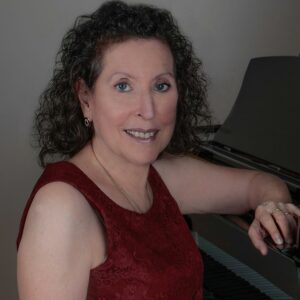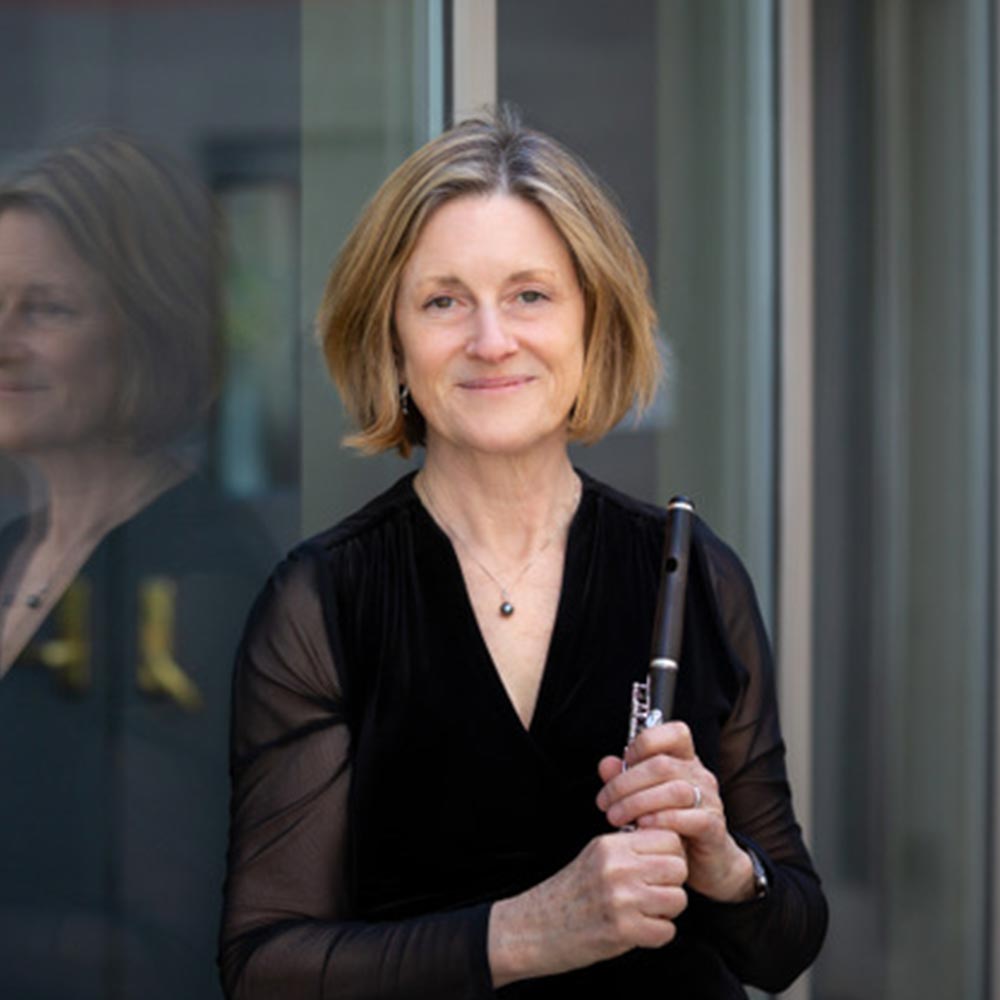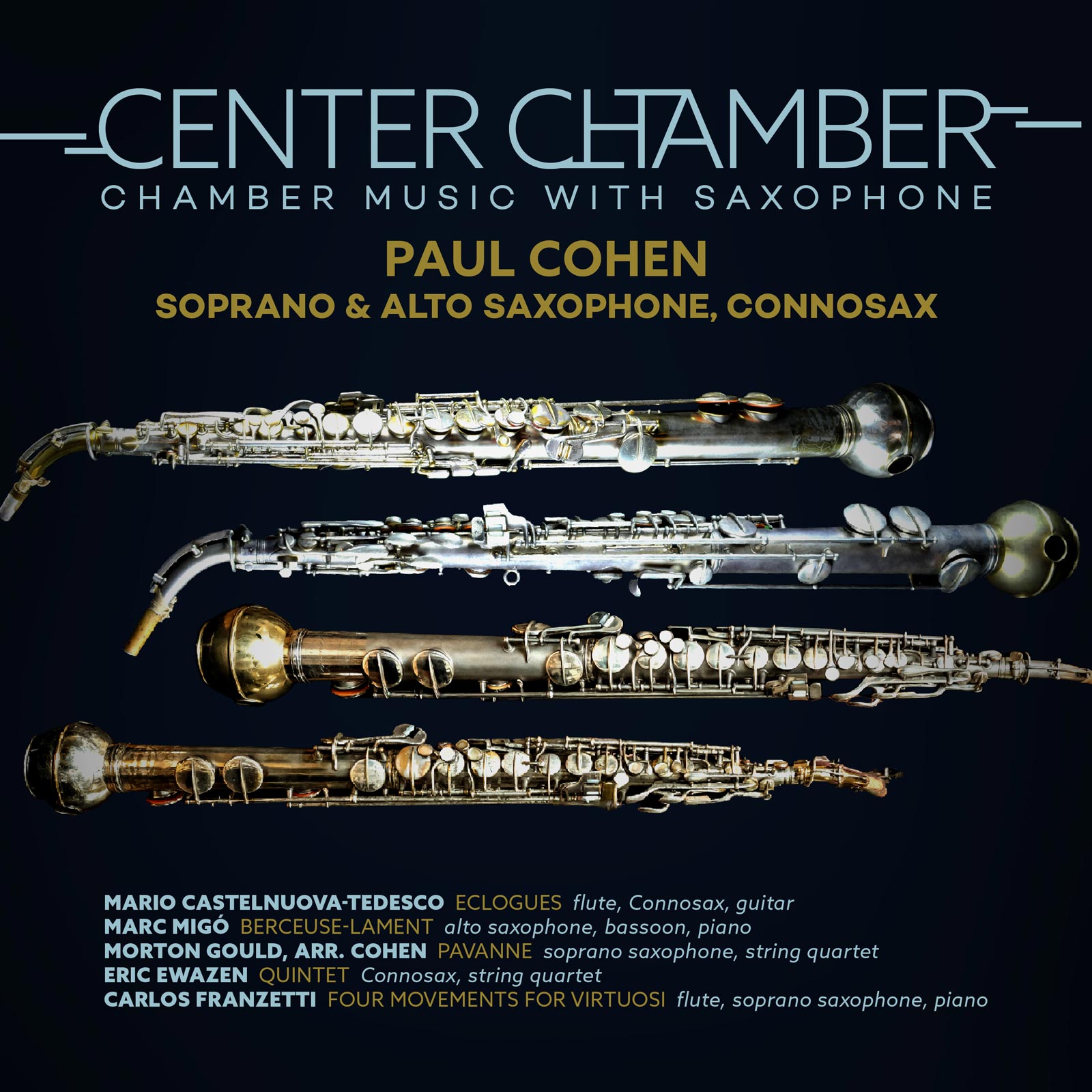Center Chamber
Paul Cohen soprano & alto saxophone, connosax
Mario Castelnuova-Tedesco composer
Morton Gould composer
Marc Migró composer
Eric Ewazen composer
Carlos Franzetti composer
On CENTER CHAMBER, wind, string, and keyboard instrumentalists come together to perform a collection of original and intimate compositions that include the saxophone — particularly Paul Cohen’s conn-o-sax, a rare and long forgotten instrument given new life in contemporary works. The conn-o-sax brings a dark, contemplative quality and infuses a unique tonal and musical spirit to these often lively, brooding, and captivating works. The engaging and brilliant intimacy of the playing eloquently reveals the unique emotional and musical bonds that tie together these exceptional artists. Listeners will undoubtedly agree: CENTER CHAMBER offers a listening experience as special and engaging as the instrument it features.
Listen
Stream/Buy
Choose your platform
Track Listing & Credits
| # | Title | Composer | Performer | |
|---|---|---|---|---|
| 01 | Eclogues: Andante quieto | Mario Castelnuova-Tedesco | Kathleen Nester, flute; Paul Cohen, connosax; Oren Fader, guitar | 2:59 |
| 02 | Eclogues: Allegro con spirito | Mario Castelnuova-Tedesco | Kathleen Nester, flute; Paul Cohen, connosax; Oren Fader, guitar | 2:28 |
| 03 | Eclogues: Lento Elegiaco | Mario Castelnuova-Tedesco | Kathleen Nester, flute; Paul Cohen, connosax; Oren Fader, guitar | 3:32 |
| 04 | Eclogues: Allegro vivace con spirito | Mario Castelnuova-Tedesco | Kathleen Nester, flute; Paul Cohen, connosax; Oren Fader, guitar | 2:25 |
| 05 | Berceuse-Lament | Marc Migó | Paul Cohen, alto saxophone; Mark Timmerman, bassoon; Anna Keiserman, piano | 8:29 |
| 06 | Pavanne | Morton Gould, arr. Paul Cohen | Paul Cohen, soprano saxophone; Manhattan Chamber Orchestra String Quartet | Urara Mogi, Maxim Zheleznyak - violin; Richard Aulden Clark, viola; Peter Prosser, cello | 3:12 |
| 07 | Quintet for Connosax and String Quartet (1989/2006): Allegro ritmico | Eric Ewazen | Paul Cohen, connosax; Manhattan Chamber Orchestra String Quartet | Urara Mogi, Maxim Zheleznyak - violin; Richard Aulden Clark, viola; Peter Prosser, cello | 3:41 |
| 08 | Quintet for Connosax and String Quartet (1989/2006): Moderato | Eric Ewazen | Paul Cohen, connosax; Manhattan Chamber Orchestra String Quartet | Urara Mogi, Maxim Zheleznyak - violin; Richard Aulden Clark, viola; Peter Prosser, cello | 6:45 |
| 09 | Quintet for Connosax and String Quartet (1989/2006): Allegro molto | Eric Ewazen | Paul Cohen, connosax; Manhattan Chamber Orchestra String Quartet | Urara Mogi, Maxim Zheleznyak - violin; Richard Aulden Clark, viola; Peter Prosser, cello | 2:52 |
| 10 | Quintet for Connosax and String Quartet (1989/2006): Fugue | Eric Ewazen | Paul Cohen, connosax; Manhattan Chamber Orchestra String Quartet | Urara Mogi, Maxim Zheleznyak - violin; Richard Aulden Clark, viola; Peter Prosser, cello | 2:49 |
| 11 | Four Movements for Virtuosi: Palisades | Carlos Franzetti | Kathleen Nester, flute; Paul Cohen, soprano saxophone; Allison Brewster Franzetti, piano | 8:44 |
| 12 | Four Movements for Virtuosi: Baya | Carlos Franzetti | Kathleen Nester, flute; Paul Cohen, soprano saxophone; Allison Brewster Franzetti, piano | 4:19 |
| 13 | Four Movements for Virtuosi: Melancolico | Carlos Franzetti | Kathleen Nester, flute; Paul Cohen, soprano saxophone; Allison Brewster Franzetti, piano | 4:21 |
| 14 | Four Movements for Virtuosi: Finale | Carlos Franzetti | Kathleen Nester, flute; Paul Cohen, soprano saxophone; Allison Brewster Franzetti, piano | 2:59 |
Tracks 1-5, 11-14
Recorded 2021-2022 at Sound Imagination in Rahway NJ
Engineer & Mixing Edward B. Kessel
Tracks 6-10
Recorded January 2013 at Caroll’s in New York City NY
Mastering Melanie Montgomery
Producers Allison Brewster Franzetti, Paul Cohen
EQUIPMENT
Soprano Saxophone
Buescher curved, gold plate c. 1925, Caravan Mouthpiece, Daddario 3.5 reeds (Gould)
Rampone curved, gold plate. c. 2018, Mana mouthpiece Daddario 3.5 reeds (Franzetti)
Alto Saxophone
Selmer Mark VI c. 1964, Mana mouthpiece, 3.0+ Daddario reeds
Conn-o-sax
Silver plate with gold bell, c. 1929, Original Conn F mouthpiece.
Executive Producer Bob Lord
A&R Director Brandon MacNeil
VP of Production Jan Košulič
Audio Director Lucas Paquette
VP, Design & Marketing Brett Picknell
Art Director Ryan Harrison
Design Edward A. Fleming, Morgan Hauber
Publicity Patrick Niland, Aidan Curran
Artist Information

Paul Cohen
Paul Cohen is a sought-after saxophonist for orchestral and chamber concerts and solo recitals. He has appeared as soloist with the San Francisco Symphony, Richmond Symphony, New Jersey Symphony, Charleston Symphony, and the Philharmonia Virtuosi. His many solo orchestra performances include works by Debussy, Creston, Ibert, Glazunov, Martin, Loeffler, Husa, Dahl, Still, Villa-Lobos, Tomasi, and Cowell. He has also performed with a broad range of orchestras, including the New York Philharmonic, Metropolitan Opera (NYC), American Symphony Orchestra, Cleveland Orchestra, Santa Fe Opera, New Jersey Symphony, Oregon Symphony, San Diego Symphony, Long Island Philharmonic, Group for Contemporary Music, Greenwich Symphony, and New York Solisti.

Allison Brewster Franzetti
The 2014 and 2018 Latin Grammy® Nominee for Best Classical Album and 2008 Grammy® Nominee for Best Instrumental Soloist without Orchestra, pianist Allison Brewster Franzetti has received international acclaim from critics and audiences alike for her stunning virtuosity and musicality, both as a soloist and chamber musician. Her performances include the live Latin Grammy® Awards television broadcast, the Grammy® Awards Classical Music Tribute to Earl Wild and Lang Lang at the Walt Disney Concert Hall in Los Angeles, the American Classical Music Hall of Fame, the Robert Schumann Festival at the Marcella Sembrich Museum in Lake George NY, the Campeche Festival in Mexico, and at the opening of the VI International Festival of Music at the Teatro Colon in Buenos Aires, Argentina.
Mario Castelnuovo-Tedesco
Mario Castelnuovo-Tedesco (1895 –1968) was a composer, pianist and writer, who was born in Florence, Italy to an Italian Sephardic Jewish family. He became widely known as a composer and teacher during the 1920s and 1930s. But as Fascism and anti-semitism continued to gain influence in Italy, his personal safety was threatened, and his artistic profession curtailed.

Marc Migó
Marc Migó (b. 1993) studied piano and composition at ESMUC, in his birthplace of Barcelona, Spain. He then moved to New York to attend Juilliard. There, he earned his M.M. and D.M.A., working under the mentorship of John Corigliano. Migó has been a winner of several prestigious awards, including The Pablo Casals Festival, the 2018 Morton Gould Young Composer award, the 2020 George Enescu Prize, and the 2022 Dominick Argento Fellowship for Opera Composition. He has received commissions from such leading institutions and ensembles as UrbanArias, the Dutch National Opera, Liceu Opera House, and the New Juilliard Ensemble. His music is now published by Universal Editions.
Morton Gould
Morton Gould (1913–1996) was one of the most prominent American composers and conductors of the twentieth century. He was a musical phenomenon equally talented composing for the concert hall as well as for radio, TV, stage, and film. His works have been hailed for their accessibility and are included in the standard repertory of bands and orchestras throughout the United States and Europe. As a conductor he made over 100 recordings and served as guest conductor for many prominent American orchestras. He was the recipient of many awards, including a dozen GRAMMY nominations while winning the Pulitzer Prize and the Kennedy Center Award for lifetime achievement.

Eric Ewazen
Eric Ewazen (b. 1954) is an American composer who has been the recipient of numerous composition awards and prizes. His works have been commissioned and performed by countless soloists, chamber ensembles, and orchestras both in the United States and overseas. His music is recorded by Summit Records, d’Note Records, CRS Records, New World, Clique Track, Helicon, Hyperion, Cala, Albany, and Emi Classics. His compositions are published by Southern Music Company, International Trombone Association Manuscript Press, Keyboard Publications, Manduca Music, Encore Music, Triplo Music, and Brass Ring Editions. He has been a faculty member at Juilliard since 1980.

Carlos Franzetti
From symphonies to big band jazz, from chamber works to Latin American music and film scores, Carlos Franzetti has no limits. Winner of a GRAMMY Award in 2015, he has also won five Latin GRAMMY Awards for Best Tango Album, Best Classical Composition, and Best Instrumental Album. He has been a GRAMMY Nominee for Best Instrumental Arrangement, Best Contemporary Composition, and Best Classical Crossover Album.

Kathleen Nester
Kathleen Nester is Assistant Principal Flute/Piccolo of the New Jersey Symphony. Also a member of Orchestra Lumos in Stamford CT, she is in demand as a freelancer in NYC and has performed with such ensembles as the Orchestra of St. Luke’s, American Ballet Theater, and the New York Philharmonic. She originated the flute book for An American in Paris and has performed in many Broadway Theater productions.

Mark Timmerman
New Jersey Symphony bassoonist Mark Timmerman is an orchestra and chamber player of great diversity. He has performed with some of the great orchestras of the United States, including the Metropolitan Opera, New York Philharmonic, Chicago Symphony, Philadelphia Orchestra, and the National Symphony Orchestra. He also performs with the Radio City Orchestra in their holiday series.

Anna Keiserman
Russian-born and New York-based pianist Dr. Anna Keiserman is known for her creative programming, expressive freedom, and singular vision. Performance credits in New York City include Le Poisson Rouge, Weill Recital Hall at Carnegie Hall, and the Fête de La Musique at the invitation of the French-American Piano Society. Other notable venues include the Jay and Linda Grunin Center for the Arts, the Strand Theater, and the Ateneu Barcelonès.

Oren Fader
Classical and electric guitarist Oren Fader (www.orenfader.com) has performed hundreds of concerts in the United States, Europe, and Asia with a wide range of classical and new music groups, including the Met Chamber Ensemble, New York Philharmonic, The Chamber Music Society of Lincoln Center, and the Orpheus Chamber Orchestra.
The Manhattan Chamber Orchestra
The MCO was founded in 1987 by Richard Auldon Clark who is the conductor and artistic director in addition to being a concert violist. The orchestra is notable for its innovative, multi-cultural repertoire with a special emphasis on contemporary American music. MCO has premiered and recorded music by William Grant Still, Alec Wilder, Victor Herbert, Henry Cowell, Alan Hovhaness, Otto Luening, Randall Thompson, Eric Ewazen, David Amram, and other notable composers. The MCO has recorded over 30 albums for many labels, including Newport Classic, Koch International Classics, Avant, VOX (6), Kleos, and Classics. MCO string quartet is comprised of Urara Mogi, violin; Maxim Zhelezynak, violin; Richard Aulden Clark, viola; and Peter Prosser, cello.



